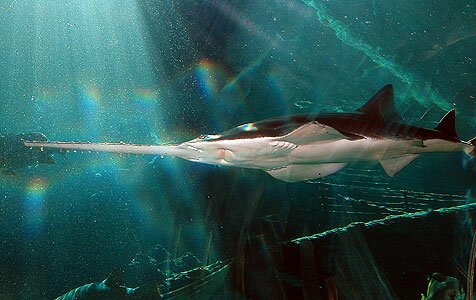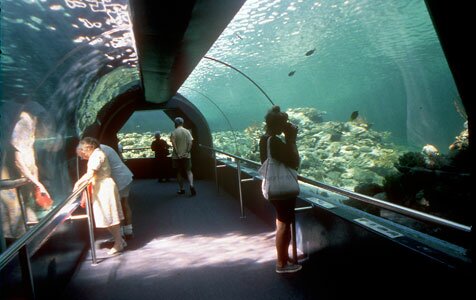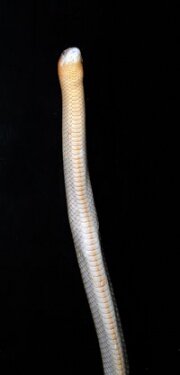Reef HQ - Great Barrier Reef Aquarium
From Microcosm Aquarium Explorer

- Sawfish, Pristis sp., in the big predators' tank, shipwreck below. Alf Jacob Nilsen

- Viewing Tunnel: predator tank left, coral reef right. Alf Jacob Nilsen
- Unusual mound display of mushroom anemones and anemonefishes. Alf Jacob Nilsen
The Reef Up Close in Australia
Text & Images by Alf Jacob Nilsen
Townsville calls itself “the city in the sun” and has the weather statistics to back it up: more than 300 days of sunshine yearly. We Norwegians, and others from more northerly or cloud-shrouded climates, find it easy to leave behind grey weather and dark days with a meagre six hours of light for the reliable brilliance of the dry tropics of Queensland, Australia.
For aquarists and underwater naturalists, Townsville is also “reef city”, home to the Australian Institute of Marine Science (AIMS), the Great Barrier Reef Authority (GBRMPA), Reef HQ, and the Museum of Tropical Queensland — all institutions devoted to coral reefs in general and to the Great Barrier Reef in particular.
Walking down Flinders Street along the saltwater Ross Creek in Townsville, the Museum of Tropical Queensland and Reef HQ are obvious landmarks and sites not to be missed by aquarium enthusiasts and coral lovers.
Contents |
Algae-Scrubbers on A Grand Scale
Reef HQ was formerly known as the Great Barrier Reef Aquarium, officially opened in June, 1987, under the auspices of Australia's Federal Government.
Reef HQ in Flinders Street, formerly the Great Barrier Reef Aquarium.
The late eighties were the heyday of the "Algal-Turf Scrubber" filtration technique, developed by Dr. W.H. Adey at the Smithsonian Institution in Washington (Adey, 1983 and 1994). Anyone who kept a reef aquarium during that pioneering period will recall that algae scrubbers were the “big thing” for some people, but greeted with suspicion by others.
Adopting Adey's designs, the GBR Aquarium was equipped with 72 separate algae-scrubbers as the aquarium’s only filtration. The scrubbers were placed on the roof, and exposed to natural sunlight and artificial illumination. The idea was to circulate the aquarium's water constantly over the beds of growing green turf and let the natural bio-chemical processes of algae growth absorb nutrients and maintain a natural biological balance in the system.
A report in Australian Science Magazine was optimistic: “Algae are the key to keeping the water clean. They remove wastes from the water and put oxygen back in.” (Eager and Peterson, 1988).
It was a fine theory.
Lessons Learned
Unfortunately time has shown that this does not work. In fact, the opposite seems to have happened! The algae filtration impoverished the system, the corals grew poorly and there was very little microfauna life surviving in the sand or in the live rock.
Pair of Lined Rabbitfish, Siganus lineatus, in the coral tank.
Today the Reef HQ team, under the supervision of Dr. Kirsten Michalek-Wagner, now works to improve the aquarium and bring back coral growth and keep microlife thriving in the system.
They experiment with the addition of calcium and have modified the aquarium to be a partial open system taking in water from Ross Creek just outside the wharf where the facility is situated. 17 years after opening the GBR-Aquarium and after much trouble, the algal scrubbers have finally been removed and replaced with protein skimmers. The Reef HQ biologists believe that the skimmers do a much better job of removing dissolved organics than the old algal turf systems.
I have visited the facility myself three times and there was a clear deterioration of the system from my first visit in 1991 to my second visit in 1998, but the system in 2004 had definitely improved a lot!
Technically impressive is the way the waves and tides are achieved. A tidal holding tank of 750.000 litres (almost 200,000 US gallons) of water make it possible to create power currents and alter the water level in the reef aquarium, a factor, which is vital for the animals.
200,000-Gallon Predator Tank
Zebra Shark, Stegasoma varium, in the predator tank. The large fishes in this aquarium come right up to you and can be studied in detail.
When you enter Reef HQ you at once feel the most helpful and friendly attitude of the staff. There are a number of people to inform you about the different parts of the aquarium and you can join them on guided tours if you like. There is also an interesting shop that among others sells a good selection of books.
The site is not just a big aquarium, but includes many smaller tanks that highlight different aspects of the coral reef. There are information-walls where photos, reef objects such as corals and very informative text learn you about reef biology. And there is an auditorium where lectures are given to the public while they sit in front of the 750.000 L predator aquarium. Personally I think this tank is really spectacular.
This aquarium is separated from the 2.5 million L coral reef aquarium by a viewing tunnel. On the one side you look into the reef aquarium and on the other side is the predator tank. The predator tank has an reconstruction of the shipwreck of the famous “Yongala” lying on a sandy substratum.
In Australia, the Yongala is so famous that it is a history lesson inself: Wreck of the Yongala.
The design and idea for the predator aquarium come from Reef HQ’s exhibit designer Glenn Shields, who describes it this way: "The skeleton of the ship—made form 5 large pieces plus the mast—are made from polypipe. Silicon moulds were made incorporating corals, clay and rocks to give it a rough surface. The moulds were then overlaid by fibreglass sheeting. Polyurethane foam was used to create extra structures, finalized by the application of low-emission resin. The back of the wreck is closed off to exclude large fish, so that we can use it as introductory chamber for new large animals."
The predator tank is occupied by several large fishes such as Black-tip Reef Shark (Carcharhinus melanopterus), Zebra Shark (Stegasoma varium) and the perhaps most impressive of all, the Sawfish (Pristis sp.).
It also contains the huge Humphead Wrasse also known as Napoleonfish (Cheilinus undulatus), groupers, several batfishes (Platax sp.), a big turtle and several schooling fishes among them a large group of Mono (Monodactylus argentus). Even some butterfly- and angelfishes manage to survive in this rough environment!
It is a magical experience to sit before the predatory tank at Reef HQ and watch these giant fishes passing by you at a very close distance.
Awesome Reef Tank
The main coral reef tank is simply huge: 2.5 million litres of water or 660,000 gallons Divers cleaning the windows nearly disappear in the tank.
While I thought the conditions of the coral reef aquarium had declined significantly from 1991 to 1998, they have certainly improved in recent years. Now the corals are growing and there is a clearly visible growth of calcareous algae, signs of life and a healthy system that were absent on my previous visit.
“No! It is not the Great Barrier Reef!”. We are looking down in the huge coral tank at Reef HQ! Note how crystal clear the water is. The depth to the sandy bottom is 4.5 m (15 ft).
The coral aquarium also contains myriad smaller fishes and it gives an excellent impression of a true coral reef fish community.
Dr. Michalek-Wagner tells me that the loss of fishes in this tank is close to zero. Some species, like the Blue Chromis (Chromis cyanea) and anemonefishes (Amphiprion spp.) spawn regularly.
Dr. Michalek-Wagner also tells a peculiar story about rabbitfishes in the tank that regularly swim into Sinularia flexibilis colonies and actually wallow among the soft corals’ tentacles. I witnessed this behaviour myself during my visit to Reef HQ. No one seems to have observed this behaviour in nature nor is anyone sure why the rabbit fishes act this way. Perhaps it is to remove parasites or to make their skin resistant to parasites?
Growing Reef
During my visit I could observe the numerous colonies and species of stony corals kept in the huge reef growing well. In some places the decoration really began to look like a growing and developing reef. (On a scale far beyond our home aquaria.)
Spawning had been observed among the corals, but not to the same extent as among populations on the Great Barrier Reef. However, the goal is to have the corals spawning regularly just as in the wild and to be able to study the spawning behaviour up close. Some of the corals in the aquarium have survived for many years despite the previously unfavourable conditions in the aquarium. Among these is a group of “Sea Whips” from the genus Juncella. Their growth from the sandy substratum among a group of giant clams is really impressive and the first time I have seen this genus growing in captivity.
A very interesting composition of fishes; a school of Striped Catfish (Plotosus lineatus), a Stingray (Dasyatis sp.) and a Guitarfish (Rhynchobatus sp.).
As mentioned earlier there are a number of small and medium sized aquariums highlighting different parts of the reef. When you enter the aquarium you meet a series of interesting square tanks with a different selection of animals. In one aquarium a pair of anemone fishes guarded their eggs under the protection of a giant host-sea anemone. A swarm of anemone fishes and mushroom anemones grew in a bed of Caulerpa in another tank, a very unusual and interesting set-up indeed!
Venomous Tank

The display of venom-equipped stonefishes, lionfishes and sea snakes is impressive. There are enough toxins in this aquarium to kill many people. This tank also contained large sea stars and Solderfishes.
Perhaps my favourite aquarium among these displays was the one with a large school of Striped Catfishes (Plotosus lineatus), a Stingray (Dasyatis sp.) and a Guitar Fish (Rhynchobatus sp.). The school of Catfish had a habit of swarming directly on top of the Stingray’s back, making the scene looking spectacular.
Another unusual, but nevertheless very interesting display, was a seagrass aquarium with mangrove roots and animals living naturally in the seagrass zone. The staff was collecting animals for this display while I was there, and I learned that Reef HQ has a limited permit to collect GBR-organisms for their aquariums.
Another small aquarium focussed on the Crown-of-Thorns Starfish (Acanthaster planci) and offers information on how this spectacular starfish kills the corals.
Getting People Beneath the Surface
Dr. Kirsten Michalek-Wagner, right, and the author in front of a bank of giant protein skimmers now installed at the aquarium of Reef HQ.
I have no doubt that Reef HQ plays a major role in informing the public about reef biology in general and especially about how to protect and maintain the Great Barrier Reef. Many Australians, although living next to the world’s largest coral reef, have never seen a live coral. Just like many of the people living along the Norwegian coastline, they know little about what is going on below the surface. Without knowledge it is impossible to protect these vulnerable habitats.
Reef HQ does, like many other public aquariums, face problems of funding. The 100,000 visitors yearly are not a lot. One clue to increasing the number of visitors is to make the aquarium even more unique: Growing and spawning corals and building a true ecosystem in miniature will attract the public over time.
It is a pity that so many years went by relying on techniques that could not work. However, with their new management, a clever crew, a new philosophy and utilising knowledge and techniques from the European reef aquarium keeping, there is a big hope that the next time I visit Townsville Reef HQ’s captive reef will be even more awe-inspiring.
Alf Jacob Nilsen is the author, with Svein A. Fosså, of Reef Secrets and the landmark The Modern Coral Reef Aquarium Series in German and English. He lives with his wife on the island of Hidrasund off the south coast of Norway.
All photos by “Bioquatic Photo – A. J. Nilsen
Bioquatic Photo
Specifications:
Technical facts. From Eager and Peterson (1988).
CORAL REEF TANK:
- Volume of water: 2.500.000 litres
- Volume of rock: 700 cubic metres (420.000 L)
- Length: 38 metres
- Width: 17 metres
- Depth: 4,5 metres (high tide)
TIDAL TANK:
- Volume of water: 750.000 litres
TUNNEL:
- Length: 17 metres
- Width: 3 metres"
PREDATOR TANK:
- Volume of water: 750.000 litres
- Length: 10 metres
- Width: 17 metres
- Depth of water: 4,5 metres
REFERENCES
ADEY, W. H. (1983): The microcosm: A new tool for reef research. Coral Reefs 1(3): 193-201.
ADEY, W. (1994): Algal Turf Scrubbers and Model Ecosystems - A Continuing Dialog. Aquarium Frontiers (Spring 1994): 1-6.
EAGER, E. and K. PETERSON: (1988). Great Barrier Reef Aquarium. Australian Science ;Mag., Issue 3. 57pages.
HQ Reef: HQ.org.au/ Website








